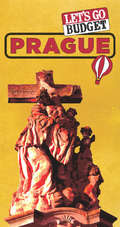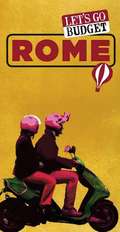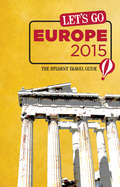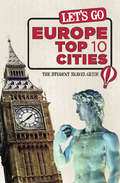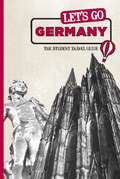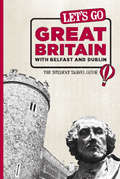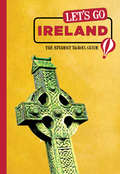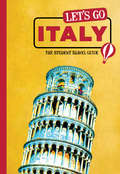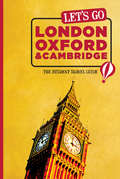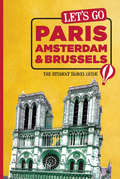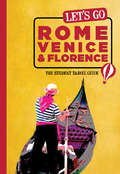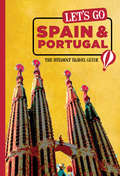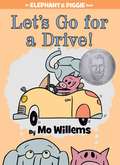- Table View
- List View
Let's Go Budget Madrid
by Harvard Student Agencies, Inc.Let's Go Budget Madrid is a budget traveler's ticket to getting the most out of a trip to Madrid-without breaking the bank. Whether you want to visit Picasso's Guernica at the Museo Nacional Reina Sofía, dance the night away at mansion-turned-discoteca Palacio Gaviria, or row around the lake at Parque del Buen Retiro, this slim, easy-to-carry guide is packed with dollar-saving information to help you make every penny count. Let's Go Budget Madrid also includes neighborhood maps to help you get oriented, plus eight pages' worth of color photos to whet your appetite for sightseeing. From how to get discount tickets for museums, performances, and public transportation to where to find cheap eats and affordable accommodations, Let's Go Budget Madrid has got you covered-and it's small enough to fit in your back pocket.Let's Go Budget Guides are for travelers who want to spend less but have more fun, students with more time than money, and anyone who appreciates a good deal. Let's Go Budget guides are written by Harvard student researchers. And who better than a starving student to figure out how to stretch a budget-and discover what's free and fun along the way?
Let's Go Budget Paris
by Inc. Harvard Student AgenciesLet's Go Budget Paris is a budget traveler's ticket to getting the most out of a trip to Paris-without breaking the bank. Whether you want to get a close look at the Mona Lisa, pay your respects to Jim Morrison at the Cimetière du Père Lachaise, or down some drinks at a bar on the Bastille's rue de Lappe, this slim, easy-to-carry guide is packed with dollar-saving information to help you make every penny count. Let's Go Budget Paris also includes neighborhood maps to help you get oriented, plus eight pages' worth of color photos to whet your appetite for sightseeing. From how to get discount tickets for museums, performances, and public transportation to where to find cheap eats and affordable accommodations, Let's Go Budget Paris has got you covered-and it's small enough to fit in your back pocket.Let's Go Budget Guides are for travelers who want to spend less but have more fun, students with more time than money, and anyone who appreciates a good deal. Let's Go Budget guides are written by Harvard student researchers. And who better than a starving student to figure out how to stretch a budget-and discover what's free and fun along the way?
Let's Go Budget Prague
by Inc. Harvard Student AgenciesLet's Go Budget Prague is a budget traveler's ticket to getting the most out of a trip to Prague-without breaking the bank. Whether you want to try one of Pivovarský Dum's unique 8-beer samplers, stroll across the Charles Bridge, or grab a hot dog in Wenceslas Square, this slim, easy-to-carry guide is packed with dollar-saving information to help you make every penny count. Let's Go Budget Prague also includes neighborhood maps to help you get oriented, plus eight pages' worth of color photos to whet your appetite for sightseeing. From how to get discount tickets for museums, performances, and public transportation to where to find cheap eats and affordable accommodations, Let's Go Budget Prague has got you covered-and it's small enough to fit in your back pocket.Let's Go Budget Guides are for travelers who want to spend less but have more fun, students with more time than money, and anyone who appreciates a good deal. Let's Go Budget guides are written by Harvard student researchers. And who better than a starving student to figure out how to stretch a budget-and discover what's free and fun along the way?
Let's Go Budget Rome
by Inc. Harvard Student AgenciesLet's Go Budget Rome is a budget traveler's ticket to getting the most out of a trip to Rome-without breaking the bank. Whether you want to make a wish at Trevi Fountain, marvel at the frescoes of the Sistine Chapel, or indulge in some of the best gelato you'll ever taste, this slim, easy-to-carry guide is packed with dollar-saving information to help you make every penny count. Let's Go Budget Rome also includes neighborhood maps to help you get oriented, plus eight pages' worth of color photos to whet your appetite for sightseeing. From how to get discount tickets for museums, performances, and public transportation to where to find cheap eats and affordable accommodations, Let's Go Budget Rome has got you covered-and it's small enough to fit in your back pocket.Let's Go Budget Guides are for travelers who want to spend less but have more fun, students with more time than money, and anyone who appreciates a good deal. Let's Go Budget guides are written by Harvard student researchers. And who better than a starving student to figure out how to stretch a budget-and discover what's free and fun along the way?
Let's Go Europe 2013
by Inc. Harvard Student AgenciesFrom Portugal to Hungary, from Great Britain down to Greece, Europe is a lot to take on. Luckily, the student adventurers behind Let's Go Europe 2013 think you can handle it-with a little help. Whether you're whipping through London, Barcelona, and Prague in five days or spending a leisurely year abroad, you'll get all the info you need from us. Our wit and irreverence can brighten even the drabbest Renaissance museum-if you didn't take our advice to skip it. From German beer halls to Roman ruins, Let's Go Europe 2013 is your ticket to adventure.Let's Go publishes the world's favorite student travel guides, written entirely by Harvard undergraduates. Armed with pens, notebooks, and a few changes of underwear stuffed in their backpacks, our student researchers go across continents, through time zones, and above expectations to seek out invaluable travel experiences for our readers. Let's Go has been on the road for 50 years and counting: We're on a mission to provide our readers with sharp, fresh coverage packed with socially responsible opportunities to go beyond tourism.
Let's Go Europe 2015
by Inc. Harvard Student AgenciesFrom Portugal to Hungary, from Great Britain down to Greece, Europe is a lot to take on. Luckily, the student adventurers behind Let’s Go Europe 2015 think you can handle it--with a little help. Whether you’re whipping through London, Barcelona, and Prague in five days or spending a leisurely year abroad, you’ll get all the info you need from us. Our wit and irreverence can brighten even the drabbest Renaissance museum--if you didn’t take our advice to skip it. From German beer halls to Roman ruins, Let's Go Europe 2015 is your ticket to adventure. Let's Go publishes the world's favorite student travel guides, written entirely by Harvard undergraduates. Armed with pens, notebooks, and a few changes of underwear stuffed in their backpacks, our student researchers go across continents, through time zones, and above expectations to seek out invaluable travel experiences for our readers. Let's Go has been on the road for 55 years and counting: We're on a mission to provide our readers with sharp, fresh coverage packed with socially responsible opportunities to go beyond tourism.
Let's Go Europe Top 10 Cities
by Harvard Student Agencies, Inc.Welcome to Europe's ten most popular cities-Let's Go style. This single-volume travel guide is packed with info on London, Paris, Rome, Florence, Venice, Madrid, Barcelona, Berlin, Prague, and Amsterdam for students and backpackers on a budget. If you're taking a whirlwind tour of Europe, Let's Go Europe Top 10 Cities is the way to go-it will help you find the most affordable hostels and hotels, tell you where to go to meet new friends at trendy cafés and clubs, and lead you to the most interesting (and quirky) sights. This guide has the perfect mix of classic and modern Europe: you'll learn where to taste the crème de la crème of French cuisine in Paris, experience the vibrant nightlife in Prague, and tango with the best of them in Madrid-all while getting the most for your euro (or pound).Let's Go publishes the world's favorite student travel guides, written entirely by Harvard undergraduates. Armed with pens, notebooks, and a few changes of underwear stuffed in their backpacks, our student researchers go across continents, through time zones, and above expectations to seek out invaluable travel experiences for our readers. Let's Go has been on the road for 50 years and counting: We're
Let's Go Europe Top 10 Cities
by Harvard Student Agencies, Inc.Welcome to Europe's ten most popular cities-Let's Go style. This single-volume travel guide is packed with info on London, Paris, Rome, Florence, Venice, Madrid, Barcelona, Berlin, Prague, and Amsterdam for students and backpackers on a budget. If you're taking a whirlwind tour of Europe, Let's Go Europe Top 10 Cities is the way to go-it will help you find the most affordable hostels and hotels, tell you where to go to meet new friends at trendy cafés and clubs, and lead you to the most interesting (and quirky) sights. This guide has the perfect mix of classic and modern Europe: you'll learn where to taste the crème de la crème of French cuisine in Paris, experience the vibrant nightlife in Prague, and tango with the best of them in Madrid-all while getting the most for your euro (or pound).Let's Go publishes the world's favorite student travel guides, written entirely by Harvard undergraduates. Armed with pens, notebooks, and a few changes of underwear stuffed in their backpacks, our student researchers go across continents, through time zones, and above expectations to seek out invaluable travel experiences for our readers. Let's Go has been on the road for 50 years and counting: We're
Let's Go European Riviera
by Harvard Student Agencies, Inc.Welcome to the European Riviera, playground of the rich and famous-but we're doing it Let's Go style, so taking it to the beach won't mean taking it from your wallet. Our student researchers worked their way through Italy, France, and Spain's most beautiful Mediterranean beaches, from Capri to the Costa del Sol, to find you the student side of life in these ritzy resorts. From the prettiest campsites on the Côte d'Azur to the cheapest clubs in Majorca, Let's Go European Riviera is packed with the facts that student travelers need and the insider info they want-so grab a copy, and get into the sunshine!Let's Go European Riviera covers: the Bay of Naples (including Pompeii, Herculaneum, and the Isle of Capri), the Amalfi Coast, Cinque Terre, Nice, Monaco, the Côte d'Azur (including Antibes, Cannes, Saint-Tropez, and Marseille), Barcelona, Sitges, Majorca, Ibiza, Valencia, Alicante, and the Costa del Sol.
Let's Go France
by Harvard Student Agencies, Inc.France is often distilled down to a pretty picture: the Eiffel Tower illuminated against the night sky, a field of lavender in Provence, or an extravagant château reflected in the still waters of the Loire. The image is nice, yes - but the fearless researchers at Let's Go have dug a little deeper. They've braved bicycle trips in torrential downpours, mixed-up ferry schedules, and overbooked hostels to weed out the authentic from the postcard-perfect. Whether travelers are searching for an Impressionist masterpiece or the taste of an authentic bouillabaisse, France is bound to leave them breathless.
Let's Go Germany
by Harvard Student Agencies, Inc.Welcome to Germany - Let's Go style. Poised at the juncture of tradition and cosmopolitanism, Germany offers student travelers culture, intellectual wonder, and beer-fueled adventure. Let's Go's intrepid student researchers have scoured the country to bring travelers the best information on everything from the hottest street art in Berlin to the best ski slopes in the Alps - all on a student-friendly budget. Whether planning for a summer of backpacking from Munich to Hamburg or gearing up for a year of study at Germany's oldest university in Heidelberg, Let's Go Germany is the perfect resource for student travelers.
Let's Go Great Britain with Belfast & Dublin
by Harvard Student Agencies, Inc.A trip to Britain can really break the bank - but not with Let's Go to help you out. Our student researchers have trekked up and down the Isle to bring you the most exciting, accommodating, and affordable places to sleep, eat, and party it has to offer. Pontificate in front of priceless works of art - free of charge - at London's major museums, or experience Edinburgh's internationally renowned arts festivals. Whether travelers are hot on the trail of Shakespeare and Virginia Woolf or keen on hiking the snowy peaks of Wales, Let's Go Great Britain will show them how to make the most of their quid.
Let's Go Ireland
by Harvard Student Agencies, Inc.Welcome to Ireland, the land of congeniality, camaraderie, and craic. Visitors may come to Ireland for its rustic charm, emerald hills, heathered crags, and misty seacliffs-or for the festivals, exhibits, musical performances, and rollicking nightlife of its up-and-coming cities-but they stay for the hospitality and friendliness that virtually radiates from the Irish people. Bone up on Irish folklore in Yeats Country, find some peace and quiet along the Kerry Way, or sip on a pint of Guinness and sway to traditional music in a Dublin pub-no matter what kind of trip you choose, you can't go wrong with Let's Go Ireland.Let's Go publishes the world's favorite student travel guides, written entirely by Harvard undergraduates. Armed with pens, notebooks, and a few changes of underwear stuffed in their backpacks, our student researchers go across continents, through time zones, and above expectations to seek out invaluable travel experiences for our readers. Let's Go has been on the road for 50 years and counting: We're on a mission to provide our readers with sharp, fresh coverage packed with socially responsible opportunities to go beyond tourism.
Let's Go Israel
by Harvard Student Agencies, Inc.Any book can direct you to Jerusalem's Western Wall or Bethlehem's churches, but only the intrepid student researchers of Let's Go Israel can lead you headlong into this ancient destination's blossoming new identity as a study abroad haven and budget traveler's dream. Relax on a beach in Haifa, snorkel in the waters of Eilat, visit Petra's tombs in Jordan, and unwind in Tel Aviv-our student writers have the inside scoop on the best grub and the most affordable rooms for wherever you want to crash in every location. Whether you want to try a traditional Biblical meal at Jerusalem's Eucalyptus restaurant or take a soothing mud bath at the Dead Sea's Ein Gedi Spa, Let's Go Israel has got you covered.Let's Go publishes the world's favorite student travel guides, written entirely by Harvard undergraduates. Armed with pens, notebooks, and a few changes of underwear stuffed in their backpacks, our student researchers go across continents, through time zones, and above expectations to seek out invaluable travel experiences for our readers. Let's Go has been on the road for 50 years and counting: We're on a mission to provide our readers with sharp, fresh coverage packed with socially responsible opportunities to go
Let's Go Israel
by Harvard Student Agencies, Inc.Any book can direct you to Jerusalem's Western Wall or Bethlehem's churches, but only the intrepid student researchers of Let's Go Israel can lead you headlong into this ancient destination's blossoming new identity as a study abroad haven and budget traveler's dream. Relax on a beach in Haifa, snorkel in the waters of Eilat, visit Petra's tombs in Jordan, and unwind in Tel Aviv-our student writers have the inside scoop on the best grub and the most affordable rooms for wherever you want to crash in every location. Whether you want to try a traditional Biblical meal at Jerusalem's Eucalyptus restaurant or take a soothing mud bath at the Dead Sea's Ein Gedi Spa, Let's Go Israel has got you covered.Let's Go publishes the world's favorite student travel guides, written entirely by Harvard undergraduates. Armed with pens, notebooks, and a few changes of underwear stuffed in their backpacks, our student researchers go across continents, through time zones, and above expectations to seek out invaluable travel experiences for our readers. Let's Go has been on the road for 50 years and counting: We're on a mission to provide our readers with sharp, fresh coverage packed with socially responsible opportunities to go
Let's Go Italy
by Harvard Student Agencies, Inc.Italy is the place for amazing food, the best vino, epic art, unparalleled natural beauties, and some seriously tight leather pants. The Let's Go student researchers endured gallons of gelato, pounds of pizza, miles of museums, countless clubs, and as many ruins as the Romans left behind - all to bring travelers the most comprehensive coverage of Italy, with plenty of witty asides. Get ready to experience adventure and la dolce far niente with Let's Go Italy.
Let's Go London, Oxford & Cambridge
by Harvard Student Agencies, Inc.Welcome to London, Oxford, and Cambridge-Let's Go style. Discover some of the best-kept culinary secrets in London's West End. Pay a visit to Oxford, whose halls have churned out the likes of WH Auden and Albert Einstein, or Emma Thompson's alma mater, Cambridge, where the student-not the tourist-is king. Whether you're visiting for a summer or a semester, there's time to take in all the coolest theaters, galleries, and most spectacular historical landmarks-and without breaking the bank.Let's Go publishes the world's favorite student travel guides, written entirely by Harvard undergraduates. Armed with pens, notebooks, and a few changes of underwear stuffed in their backpacks, our student researchers go across continents, through time zones, and above expectations to seek out invaluable travel experiences for our readers. Let's Go has been on the road for 50 years and counting: We're on a mission to provide our readers with sharp, fresh coverage packed with socially responsible opportunities to go beyond tourism.
Let's Go Mad: A Year Abroad in Search of Utopia and Enlightenment
by Rob Binkley Murphy Hooker"In my madness I bought the ticket. I took the ride. I needed to live. I needed to suffer. I had to go." -Rob BinkleyRob Binkley is a young Silicon Valley entrepreneur who has it all at twenty-seven: a thriving business, beautiful girlfriend, and great life. But something is missing. Despite his success, Rob fantasizes about shedding the shackles of his American Dream to live wild and free like his hero Hunter S. Thompson. As Rob's world begins to fall apart, a visit from his Zen madman of a best friend, Brian, convinces him to hatch an escape plan and follow his bliss for authentic life experiences. Will he find the meaning of life while backpacking through twenty-three countries, or will he and Brian go mad wallowing in the extreme debauchery the world has to offer?A tribute to gonzo beat literature, Let's Go Mad is the amazing true story of their year abroad backpacking across the globe on a sideways search in all the wrong places, with all the wrong people, at all the wrong times. After Brian's lust for life inspires Rob to embrace his inner lunatic, pushing the limits of sanity (and their friendship) into one merry blur-they come to realize there's more to life than mere mad experience. They must have a "personal renaissance" or die trying.
Let's Go Paris
by Harvard Student Agencies, Inc.Welcome to Paris - Let's Go style. The student researchers have roamed the streets of the City of Lights to bring travelers fresh, exciting coverage - from their penniless student pockets to yours. Need an affordable place to sleep? Don't forget your sleep sack! Hungry? Try a prix fixe served in complete darkness. And on those rainy days, Let's Go have travelers wandering Monet's hidden collection before they can say "merveilleux." Pack your bags, perfect your accent, and grab Let's Go Paris - it will be an unforgettable experience.
Let's Go Paris, Amsterdam & Brussels
by Harvard Student Agencies, Inc.Whether you want to walk along the Seine, explore Monet's hidden collection, bike along cheery canals, or take in a burlesque show, Paris, Amsterdam, and Brussels have plenty to offer-and Let's Go's student researchers have found it all for you. Need an affordable place to sleep? We've got you covered (don't forget your sleep sack). Hungry? We'll show you the way to a prix fixe served in complete darkness. We've hunted down the facts and freebies that students want so you can enjoy these three cities to the fullest, complete with café au lait, cherry beer, and chocolate-lots and lots of chocolate. Grab a copy of Let's Go Paris, Amsterdam & Brussels, and gear up for a European excursion unlike any other. Let's Go publishes the world's favorite student travel guides, written entirely by Harvard undergraduates. Armed with pens, notebooks, and a few changes of underwear stuffed in their backpacks, our student researchers go across continents, through time zones, and above expectations to seek out invaluable travel experiences for our readers.
Let's Go Rome, Venice & Florence
by Inc. Harvard Student AgenciesWelcome to Italy, the laid-back land of Roman majesty, Tuscan sunshine, and Venetian romance-at least, that's what they say in the tourist brochures. Our student researchers have lived the real vita bella-dodging rogue scooters, unscheduled bus strikes, and overeager Italian suitors-in order to bring you the coverage that really matters. Their irreverent, in-depth commentary will keep you entertained through scores of Michelangelos and Medicis, and guide you straight to the best gelaterias in town. Whether you're studying abroad in one city or hostel-hopping between all three, Let's Go Rome, Venice & Florence will prepare you for an adventure you'll never forget.Let's Go publishes the world's favorite student travel guides, written entirely by Harvard undergraduates. Armed with pens, notebooks, and a few changes of underwear stuffed in their backpacks, our student researchers go across continents, through time zones, and above expectations to seek out invaluable travel experiences for our readers. Let's Go has been on the road for 50 years and counting: We're on a mission to provide our readers with sharp, fresh coverage packed with socially responsible opportunities to go beyond tourism.
Let's Go Spain, Portugal & Morocco
by Inc. Harvard Student AgenciesLet's Go's intrepid student researchers have canvassed the diverse landscapes of these three countries to bring travelers the scoop on Spain's best back-alley botegas, Portugal's tastiest bacalhau dishes, and how to barter like a local in Morocco. With extensive coverage of everything from bullfighters to Berbers, they have left nothing to chance. Get ready for diverse culture, delicious tapas, lazy beach siestas, and nonstop nocturnal revelry before setting off on an unforgettable adventure with Let's Go Spain and Portugal with Morocco.
Let's Go Traveling
by Robin Rector KruppPresents a trip to the prehistoric caves of France, the pyramids of Egypt, the Maya temples of Mexico, and other ancient wonders of the world.
Let's Go for a Drive! (An Elephant and Piggie Book)
by Mo WillemsMeet Elephant Gerald and Piggie, winners of two Theodor Seuss Geisel Medals and recipients of two Geisel Honors!<P><P> Gerald is careful. Piggie is not.<P> Piggie cannot help smiling. Gerald can.<P> Gerald worries so that Piggie does not have to.<P> Gerald and Piggie are best friends.<P> In Let's Go for a Drive! Gerald and Piggie want to hit the road! But the best-laid plans of pigs and elephants often go awry.<P> Winner of the Theodore Seuss Geisel Honor
Let's Go to the Beach
by Chronicle BooksA kid&’s guide to fun in the sun, packed with seaside trivia and beach-friendly games and activities. Let&’s Go to the Beach includes everything kids need to have a blast at the beach! Discover: fun facts about oceans, marine life, seashells, and more tips on enjoying the beach safely sea-themed activities, games, art projects, and scavenger hunts things to do on your own or with others


